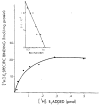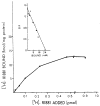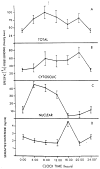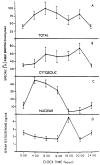Circadian rhythm of hepatic cytosolic and nuclear estrogen and androgen receptors
- PMID: 3710067
- PMCID: PMC2965517
- DOI: 10.1016/0016-5085(86)90456-7
Circadian rhythm of hepatic cytosolic and nuclear estrogen and androgen receptors
Abstract
Mammalian liver is a sex steroid-responsive tissue. The effects of these hormones presumably are mediated by hepatic estrogen receptors (ER) and androgen receptors (AR). Serum levels of sex hormones display circadian rhythms. Further, estrogens and androgens are commonly administered; administration of these agents is associated frequently with liver disease. Therefore, we investigated whether the cytosolic and nuclear sex steroid receptors also display a similar circadian rhythm, and whether variations occurred in the distribution of receptors between cytosolic and nuclear compartments. Animals were killed every 4 h from midnight till the following midnight; cytosolic and nuclear levels of both ER and AR were measured. Cytosolic ER reached a maximum level at 4 AM, and a minimum at 8 PM and midnight of both days. Nuclear ER was highest at 8 AM and lowest at 4 PM and 8 PM, a pattern which parallels variations in serum estradiol levels. Cytosolic AR was highest at 8 PM and lowest at midnight and 4 AM. Nuclear AR was highest at 4 AM and lowest at 4 PM and 8 PM. The highest level of nuclear AR does not correspond to the maximum serum testosterone level, which occurred at 4 PM. The total hepatic content of both ER and AR was not constant over the 24-h period, but varied considerably with time of day. These studies suggest that both ER and AR show a distinct circadian rhythm in subcellular compartmentalization, and that total hepatic content of ER and AR varies significantly during a 24-h period.
Figures




Similar articles
-
Effect of spironolactone and potassium canrenoate on cytosolic and nuclear androgen and estrogen receptors of rat liver.Gastroenterology. 1987 Oct;93(4):681-6. doi: 10.1016/0016-5085(87)90428-8. Gastroenterology. 1987. PMID: 3623016 Free PMC article.
-
Circadian rhythm of hepatic cytosolic and nuclear estrogen receptors.Chronobiol Int. 1986;3(4):207-11. doi: 10.3109/07420528609079538. Chronobiol Int. 1986. PMID: 3677204 Free PMC article.
-
Orthotopic liver transplantation and the cytosolic estrogen-androgen receptor status of the liver: the influence of the sex of the donor.Hepatology. 1989 Nov;10(5):861-6. doi: 10.1002/hep.1840100519. Hepatology. 1989. PMID: 2807167 Free PMC article.
-
[Regularities in androgen reception in rat liver and its role in realizing direct androgenous effects].Biokhimiia. 1991 Apr;56(4):681-6. Biokhimiia. 1991. PMID: 1912071 Russian.
-
Estrogen receptors and androgen receptors in the mammalian liver.J Steroid Biochem. 1987;27(4-6):1109-18. doi: 10.1016/0022-4731(87)90197-x. J Steroid Biochem. 1987. PMID: 3320548 Review.
Cited by
-
Sex hormone-related functions in regenerating male rat liver.Gastroenterology. 1986 Nov;91(5):1263-70. doi: 10.1016/s0016-5085(86)80026-9. Gastroenterology. 1986. PMID: 3758617 Free PMC article.
-
Nuclear receptors rock around the clock.EMBO Rep. 2014 May;15(5):518-28. doi: 10.1002/embr.201338271. Epub 2014 Apr 15. EMBO Rep. 2014. PMID: 24737872 Free PMC article. Review.
-
Effect of spironolactone and potassium canrenoate on cytosolic and nuclear androgen and estrogen receptors of rat liver.Gastroenterology. 1987 Oct;93(4):681-6. doi: 10.1016/0016-5085(87)90428-8. Gastroenterology. 1987. PMID: 3623016 Free PMC article.
-
Regulation of liver size and regeneration: importance in liver transplantation.Transplant Proc. 1988 Feb;20(1 Suppl 1):494-7. Transplant Proc. 1988. PMID: 3279642 Free PMC article. No abstract available.
-
Gastric 17β-estradiol in portal vein and liver Esr1 make a circadian rhythm in systemic circulation in male rats.Endocrine. 2016 Aug;53(2):565-73. doi: 10.1007/s12020-016-0971-0. Epub 2016 May 10. Endocrine. 2016. PMID: 27165169
References
-
- Eagon PK, Porter LE, Francavilla A, et al. Estrogen and androgen receptors in liver: their role in liver disease and regeneration. Semin Liver Dis. 1985;5:59–69. - PubMed
-
- Corvol PL, Chrambach A, Rodbard D, et al. Physical properties and binding capacity of testosterone-binding globulin in human plasma determined by polyacrylamide electrophoresis. J Biol Chem. 1971;246:3435–43. - PubMed
-
- Laragh JH, Bauer L, Brunner HR, et al. Renin angiotensin and aldosterone system in pathogenesis and management of hypertensive vascular disease. Am J Med. 1972;52:633–53. - PubMed
-
- Menard J, Corvol P, Foliot A, et al. Effects of estrogens on renin substrate and uterine weights in rats. Endocrinology. 1973;93:747–51. - PubMed
-
- Song CS, Rifkind AB, Gillete PN, et al. The effect of estrogens, progestins and pregnancy on hepatic function. Am J Obstet Gynecol. 1969;195:813–47. - PubMed
Publication types
MeSH terms
Substances
Grants and funding
LinkOut - more resources
Full Text Sources
Other Literature Sources
Research Materials

